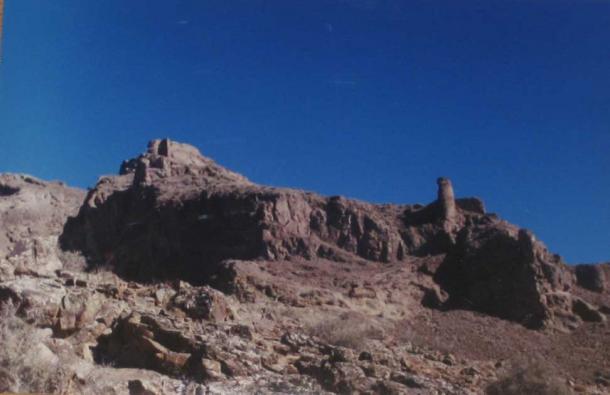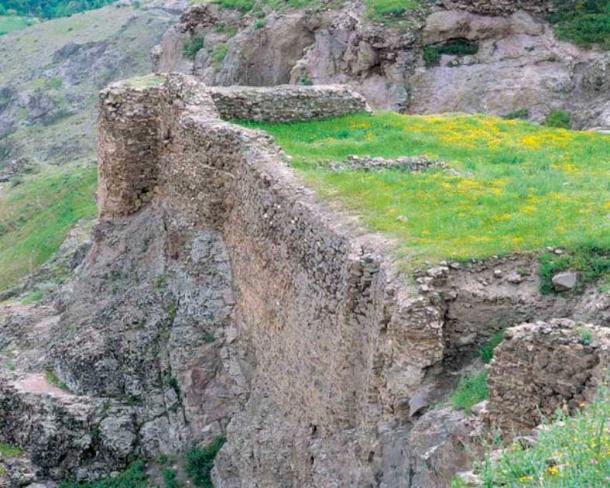[ad_1]
Lambsar Castle, representing the gargantuan castle in the popular ‘Assassin’s Creed’ franchise, has yielded stunning astrolabe tile fragments during excavations. Located in the Central Alburz mountains in Iran, south of the Caspian Sea, it was one of the fortifications used by Nizari Ismaili, leader of a sect that established the Nizari or Alamut State (1090-1273 AD). The tile fragments, supposedly part of an astrolabe modelling the universe, are in a gorgeous mix of turquoise, light blue, white, and black, and date to the Middle Islamic period.
Examining the Finds and the Lambsar Castle Fortification
The study and archaeological survey, conducted by Iranian archaeologists, was led by Kambiz Kabiri, reports Tehran Times . The tiles were located in the castle’s western tower as part of a structural study to strengthen the foundations and conduct restoration works using ‘existing collapsed masonry’. An adobe wall with a stone foundation behind a round tower was also identified during the excavation.

Lambsar Fort, picture from the south. (Mehrzad/ CC BY 3.0 )
In its heyday, the castle was a major stronghold of the Nizari state, whose followers were called Assassins or Hashshashins (meaning hashish smokers/users, perhaps the origin of the word ‘assassin’). Strategically built between extremely deep valleys that surround the castle, accessing it from the east and west sides are nearly impossible. The gargantuan building is 190 meters (623 feet) in its width, and consists of two huge-layered parapets, with 1.2 meters (3.93 feet) wide cut stone walls.
The castle was fully equipped to brave the extremities of weather, with rich water reservoirs and grain stores in the south and southeast of the complex. High towers guard every end of the complex, with a robust water system in place that can still be seen by tourists. The north side also possesses the remnants of a huge building with 4 smaller extensions facing the east.

Top view of one of the sections of Lambsar Fort, showing walls which were up to 1.2 meters thick. (Soroush90gh, CC BY-SA 3.0 )
The Hashshashins: A Guerrilla Sect That Feared None
The Assassins, also called Batiniyya, Ta’limiyya, Isma’iliyya, Nizariyya, were a fidā’i military group founded by Hassan-I Sabbah (AD 1050 – 1124), reports Tehran Times . A Fatimid document written by Caliph al-Amir around 1120 AD also refers to them as the Hashshashin. Their modus operandi were espionage missions and assassinations of key enemies and political opponents in public – this included three caliphs, a ruler of Jerusalem, and several Muslim and Christian leaders, amongst others.
Their very formation came from the original schism in Islam in the 7th century, which had caused a divide between the Shias and the Sunnis. The Ismailis were Shias, who emerged from a power struggle within the Shia fold itself that had caused Prince Nizar to flee into the Persian mountains. They were always organized as a minority number or group defending themselves against much larger groups.
This led to the formation of a number of strategic, self-sufficient fortresses, unconventional tactics and psychological warfare. Lambsar Castle was one such fortification, but the state was centred around the vital Alamut Castle, which would serve as a central base from which other missions were launched. The main problem with reconstructing the history of the Ismailis has been hostile or foreign historical sources.
In Farhad Daftary’s work on the Ismailis, he explains how despite being occupied with survival in this hostile environment, the Ismailis developed a sophisticated outlook and literary tradition. They elaborated their teachings in response to changing circumstances as witnessed by archaeological finds – manuscripts, documents, and scientific instruments aplenty.
While surviving onslaughts from several hostile neighbors, including the Mongols, against whom the Ismailis were the last line of defense in Persia, it was a cholera epidemic in 1257 which led to the fall of the fort. Combined with a sustained assault from the Mongols under Hulaku Khan, who ordered the fort to be ruined and all survivors of the epidemic to be beheaded, Lambsar was fully abandoned. There were two short lived attempts by surviving Ismailis to recapture the fort in 1275 and 1389, but these proved to be unsuccessful.
Top image: Astrolabe tile fragments recovered at Lambsar castle. Source: ILNA / Tehran Times
By Sahir Pandey
References
ABU. 2022. Ancient castle excavation yields astrolabe, tile fragments . Available at: https://www.tehrantimes.com/news/478946/Ancient-castle-excavation-yields-astrolabe-tile-fragments.
Heritage Daily. 2022. ASTROLABE TILE FRAGMENTS FOUND IN “ASSASSINS” CASTLE . Available at: https://www.heritagedaily.com/2022/11/astrolabe-tile-fragments-found-in-assassins-castle/145310.
[ad_2]
Source link
